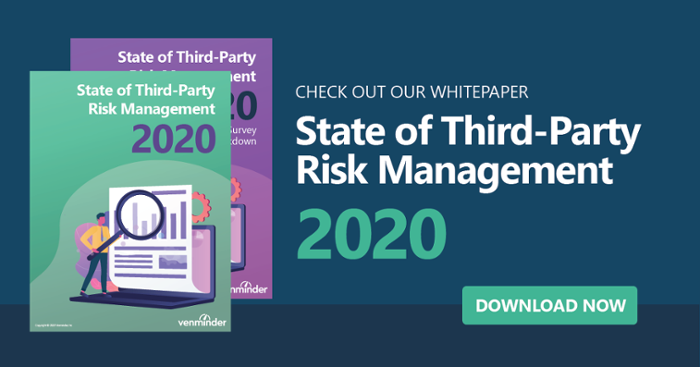For the fourth year, we’ve surveyed various organization types of all sizes across the industry to get an educated understanding of where organizations stand regarding third-party risk management. Venminder’s State of Third-Party Risk Management Survey provides insight into how financial services, financial technology and other industries manage third-party risk management.
Biggest Hurdles for Third-Party Risk Management
One survey question we asked respondents was, “What do you see as your next biggest hurdle?”
Here are the results:
- Fourth-Party Assessments – 34%
- Cybersecurity Assessments of Third Parties – 35%
- Cloud Providers – 12%
- BCP/DR Assessments – 7%
- Other – 9%
- Mobile Provider Assessments – 3%
Like last year, fourth-party assessments and cybersecurity assessments of third parties took the lead with 69% of respondents agreeing that these two areas are their next big hurdles to overcome. Interestingly, that’s down by 5% from last year. It looks like there was a very slight increase in other areas that present hurdles, too. Let’s dive further into why we think cybersecurity assessments and fourth-party assessments are still the two biggest struggles for companies.
Fourth-Party Assessments Can Be a Difficult Concept to Grasp
In an industry where you have vendors, third-party vendors, fourth-party vendors, and the list goes on, it can be difficult to drill down into exactly where you need to begin in assessing each.
Fourth-party assessments are particularly challenging for third-party risk professionals to conduct as you often have to rely on your third-party vendor to provide you with the information that you need to properly assess the fourth-party vendor. Therefore, it has become fairly common to hear that fourth-party assessments present unique obstacles.
To combat those obstacles, it’s extremely important that you set the expectations upfront with your third party by ensuring they’re aware of what you’ll need them to share with you regarding their own critical third-party vendors – such as specific due diligence requests – and how frequently you’d like to receive the information. This is a critical first step and should reduce future headaches as you attempt to collection information and assess your fourth parties.
A Focus on Cybersecurity Isn’t Going Away
It’s not very shocking that 35% of respondents say third-party cybersecurity assessments are also a big hurdle that they expect to face. Cybersecurity has been an industry hot button for a few years now. It’s not going away anytime soon. These days, every organization needs to be on high alert and aware – no matter the size or industry.
Educating your employees, third parties and contractors is an extremely important component of cybersecurity awareness. This helps ensure everyone is on the same page and doing their part to help protect your organization from cyber threats. And, fully understanding how your third parties protect your sensitive data from cybersecurity threats is crucial. No one wants to be victim of a data breach, especially a data breach that was a domino effect by a third party’s faulty security precautions.
To learn more noteworthy findings, check out the full survey results and State of Third-Party Risk Management 2020 Whitepaper for a full analysis. Download here.



















